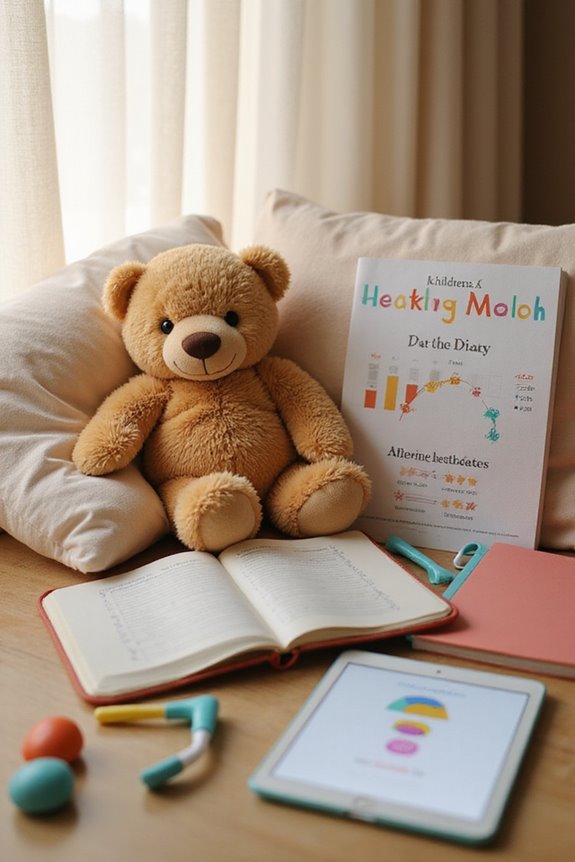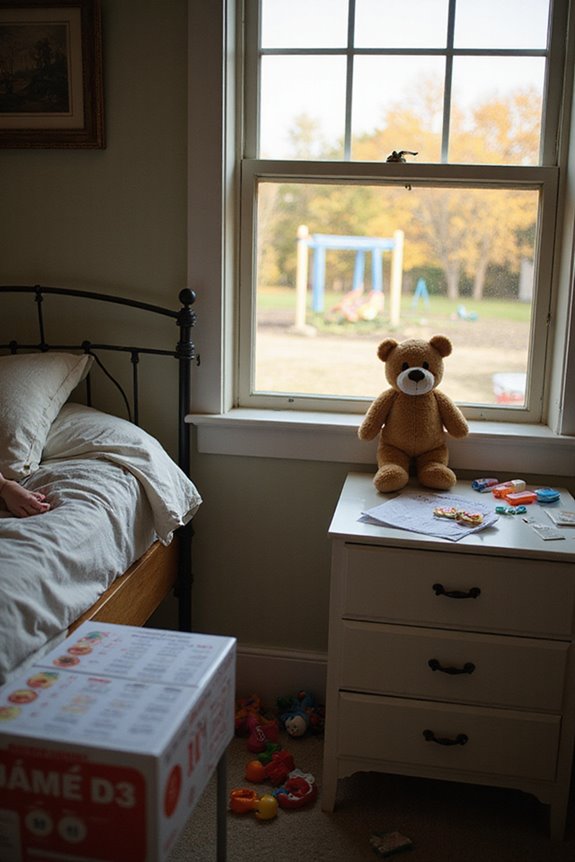Childhood chronic pain has significant long-term effects, impacting various aspects of life. Key outcomes include:
- Persistent physical health issues, such as mobility limitations and muscle weakness.
- Increased risk for psychiatric disorders, like anxiety and depression, affecting emotional well-being.
- Social isolation and reduced academic performance, hindering social functioning.
Early intervention and trauma-informed care are essential for mitigating these effects. Continued exploration reveals more about the complexity and scope of childhood chronic pain and its implications.
Key Takeaways
- Chronic pain in childhood can lead to persistent physical health issues, including muscle weakness and mobility limitations, affecting overall growth and development.
- Mental health comorbidities, such as anxiety and mood disorders, often accompany childhood chronic pain, impacting emotional well-being and coping strategies.
- Children with chronic pain may experience long-term social isolation and reduced school attendance, negatively affecting their quality of life and social development.
- Increased healthcare utilization during childhood can lead to a sustained physical health burden into adulthood, creating ongoing challenges and treatment needs.
- Early intervention and trauma-informed care can significantly improve recovery outcomes, reducing psychological distress and future disability risk associated with chronic pain.
Prevalence of Chronic Pain in Childhood
Chronic pain in childhood is a significant public health concern, affecting a substantial portion of the pediatric population. Approximately 20.8% of children and adolescents suffer from chronic pain, with prevalence rates ranging from 11% to 38%.
Key chronic pain conditions include:
- Headaches, particularly prevalent in over 16% of adolescents, especially girls post-age 12.
- Musculoskeletal pain, commonly reported among younger children.
Demographic factors influencing these statistics include:
- Gender differences: Chronic pain occurs more frequently in girls than boys, particularly in early teenage years.
- Family history: Recurrent headaches often correlate with familial patterns.
These childhood statistics reveal a pressing need for awareness and effective management strategies to mitigate the impact of chronic pain on young lives.
Types of Chronic Pain in Children

Types of chronic pain in children encompass a diverse range of conditions that can greatly impact their quality of life.
Chronic Musculoskeletal Pain
- Injury-related, illness-related, or primary types.
- Localized (e.g., ankle injuries) or generalized (e.g., arthritis).
- Often linked to connective tissue disorders.
Nociceptive Pain
- Results from nociceptor activation due to inflammation or injury.
- Chronic nociceptive pain persists beyond 3-6 months, affecting activities and social interactions.
Neuropathic Pain
- Arises from nerve damage or dysfunction.
- Less common, includes conditions like complex regional pain syndrome.
Idiopathic Chronic Pain
- Pain without identifiable cause, often linked to fibromyalgia.
- Associated with depressive symptoms, impacting daily functioning.
Each type requires a multifactorial treatment approach.
Risk Factors for Chronic Pain Persistence

Understanding the persistence of chronic pain in children requires an examination of various risk factors that contribute to its longevity.
Genetic Predisposition and Family History
- A parental history of recurrent functional pain syndromes, such as migraines and recurrent abdominal pain, increases the risk of chronic pain persistence in children.
- Early functional pain syndromes in childhood correlate with the likelihood of chronic pain symptoms later in life.
Emotional Factors
– Early anxiety, depression, and behavioral disorders are significant predictors of chronic pain persistence. Emotional distress can exacerbate pain severity and disability.
Environmental Influences
– Family dysfunction, social isolation, and socioeconomic factors impact the continuation of chronic pain. Female children show a higher risk for chronic pain persistence.
Impact on Physical Health

The impact of childhood chronic pain on physical health is multifaceted, affecting various systems and processes within the body. Key considerations include:
- Nervous System Changes: Chronic pain can lead to heightened sensitivity and altered neurotransmitter function, compromising pain modulation and increasing vulnerability to future pain.
- Musculoskeletal Function: Maladaptive physical patterns, such as poor posture and reduced activity, can result in muscle weakness and long-term mobility limitations.
- Sleep Disruption: Chronic pain often disrupts sleep, reducing quality of rest, which can exacerbate pain sensitivity and fatigue.
- Growth Development: Severe chronic pain may hinder normal physical growth, limiting engagement in essential activities for musculoskeletal development.
- Healthcare Utilization: Children with chronic pain frequently require increased medical attention, leading to a sustained physical health burden into adulthood.
Effects on Mental Health

Chronic pain in childhood considerably influences mental health, as numerous studies indicate a high prevalence of psychiatric disorders among affected youth.
- Over half of children with chronic pain report anxiety disorders and mood disorders, including depression.
- The presence of pain at multiple sites correlates with a higher burden of psychiatric symptoms.
- Older adolescents experience greater psychiatric symptoms than younger children, with risks persisting into adulthood.
- Mental health comorbidities can hinder effective coping strategies, exacerbating both pain and psychological distress.
- Youth with chronic pain often face challenges in peer relationships, resulting in social isolation and reduced school attendance.
- These factors collectively contribute to lower quality of life and increased vulnerability to severe psychological outcomes.
Addressing these mental health effects is essential for thorough pain management.
Psychological and Behavioral Consequences
Psychological and behavioral consequences of childhood chronic pain extend beyond physical discomfort, greatly affecting various aspects of a child’s life.
- Emotional Regulation: Many children struggle to manage emotions such as frustration and sadness, leading to maladaptive coping strategies, including avoidance behaviors.
- Social Withdrawal: Chronic pain can result in reduced participation in social activities, increasing feelings of loneliness and impacting the development of emotional resilience.
- Cognitive Challenges: Impaired cognitive performance, particularly in attention and memory, can hinder academic achievement and motivation.
- Long-Term Risks: Children with chronic pain are at increased risk for anxiety and depression, which may evolve into substance use issues in adulthood.
Implementing effective coping strategies can mitigate these consequences, fostering a healthier psychological state.
Family Dynamics and Social Functioning
Family dynamics are greatly influenced when a child experiences chronic pain, as the need for adjusted roles and responsibilities arises.
- Family Role Redistribution: Increased caregiving demands often lead to a shift in family tasks, placing strain on one parent, which can cause marital friction and resentment.
- Sibling Emotional Challenges: Siblings may feel neglected or burdened with extra chores, resulting in feelings of resentment or guilt. Their emotional needs may be overlooked, leading to further isolation.
- Impact on Social Functioning: Chronic pain disrupts family cohesion, limiting participation in social activities. The ongoing medical appointments and caregiving responsibilities can lead to social isolation and emotional exhaustion within the family unit.
Effective communication and support strategies are essential to mitigate these challenges.
Treatment Approaches and Their Effectiveness
Effective treatment approaches for pediatric chronic pain encompass a range of strategies that integrate behavioral, psychological, and pharmacological interventions.
Behavioral and Psychological Interventions
- Cognitive Behavioral Therapy (CBT) effectively reduces pain severity.
- Psychological therapies, including relaxation techniques, show strong evidence for managing pain and improving mood.
Multimodal and Interdisciplinary Rehabilitation Approaches
- An interdisciplinary approach combining physical therapy with psychological treatments is ideal.
- Multimodal analgesia reduces side effects compared to single modality treatments.
Pharmacological Treatments and Limitations
- Basic analgesics are insufficient alone; combination strategies are necessary for effective management.
- Opioids are rarely indicated for chronic pain in pediatrics, emphasizing careful assessment.
Emerging Studies
– Limited mechanistic clinical trials and neuroimaging studies hinder effectiveness assessment and understanding of treatment response.
Importance of Early Intervention and Trauma-Informed Care
Early intervention in pediatric chronic pain is critical for promoting ideal recovery and enhancing quality of life. Research indicates that early intervention notably improves pain self-efficacy, reduces catastrophizing symptoms, and restores normal daily activities. Key benefits include:
- A 24% reduction in psychological distress post-intervention.
- Approximately 42% decrease in pain interference following extensive care.
- An 18% reduction in future disability risk associated with chronic pain.
Trauma-informed care is essential in this situation, as it addresses adverse childhood experiences that can exacerbate pain perception. Tailoring interventions to reflect emotional trauma helps prevent retraumatization, improves engagement, and fosters a supportive environment. By integrating early intervention with trauma-informed approaches, healthcare providers can achieve better outcomes for children facing chronic pain.
Frequently Asked Questions
How Can Parents Support a Child With Chronic Pain?
Parents can support a child with chronic pain by providing emotional support and teaching effective coping strategies. Encouraging communication, maintaining routines, and celebrating achievements fosters resilience, helping the child feel understood and empowered in their journey.
Are There Specific Therapies for Childhood Chronic Pain?
Specific therapies for childhood chronic pain include cognitive therapies, which help children manage emotional responses, and physical therapies that enhance strength and flexibility. These approaches foster a supportive environment, promoting overall well-being and connection among peers.
What Role Does Diet Play in Managing Chronic Pain?
Diet plays an essential role in managing chronic pain through nutritional strategies that emphasize anti-inflammatory foods. These dietary choices can greatly reduce pain levels, enhance mobility, and foster a sense of community and belonging among individuals.
How Can Teachers Assist Students With Chronic Pain?
Teachers can assist students with chronic pain by implementing classroom accommodations and fostering empathy training. By creating supportive environments, encouraging flexibility, and promoting understanding, they help students feel valued and engaged in their learning journey.
What Resources Are Available for Families Dealing With Childhood Chronic Pain?
Ironically, amidst pain, robust support networks and educational materials flourish, guiding families through chronic challenges. These resources foster understanding and resilience, weaving a tapestry of belonging that empowers children and their families to navigate difficult journeys together.





